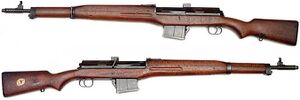Tóth OP-30
Jump to navigation
Jump to search
This article is incomplete because it is pending further input from participants, or it is a work-in-progress by one author. Please comment on this article's talk page to share your input, comments and questions. Note: To contribute to this article, you may need to seek help from the author(s) of this page. |
| Tóth Önrakodó Puska 30 OP-30 | |
|---|---|
 | |
| Type | Semi-automatic rifle |
| Place of origin | |
| Service history | |
| In service | 1930—1955 (Ruvelka) |
| Used by | |
| Wars | Siduri War Granika Border War Seven Day War |
| Production history | |
| Designer | Veronika Tóth |
| Designed | 1928 |
| Produced | 1929—1949 |
| Specifications | |
| Weight | 4.71 kg |
| Length | 1,214 mm |
| Barrel length | 622 mm |
| Cartridge | 6.5×55mm |
| Action | Direct impingement gas operated |
| Rate of fire | 40 RPM (rounds per minute) |
| Muzzle velocity | 840 m/s |
| Effective firing range | 800 m |
| Feed system | 10-round detachable box magazine |
| Sights | Hooded front blade, adjustable rear iron sight |
The Tóth OP-30 (Ruvelkan: Önrakodó Puska 30; “Self-Loading Rifle 30”) is a Ruvelkan self-loading rifle that served as the main infantry rifle of the [[Imperial Armed Forces of Ruverlka during the Siduri War and its aftermath before eventually being replaced by the Acrean StG 51 in 1955.
The OP-30 later became an icon of the Zemplen independence movements after large numbers of the rifle were covertly provided to groups fighting against Syara as part of the Granika Border War.